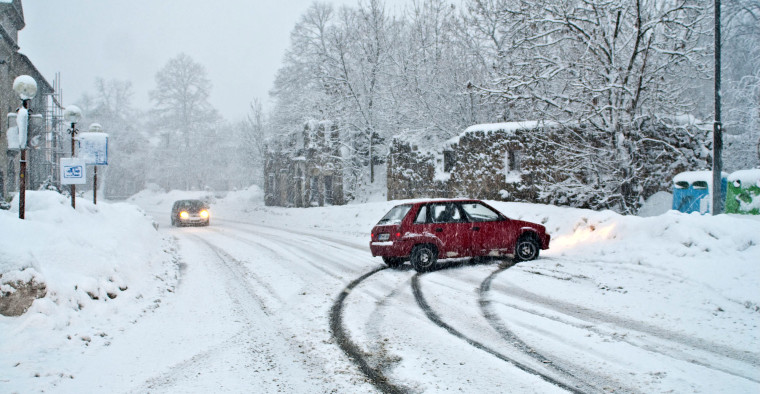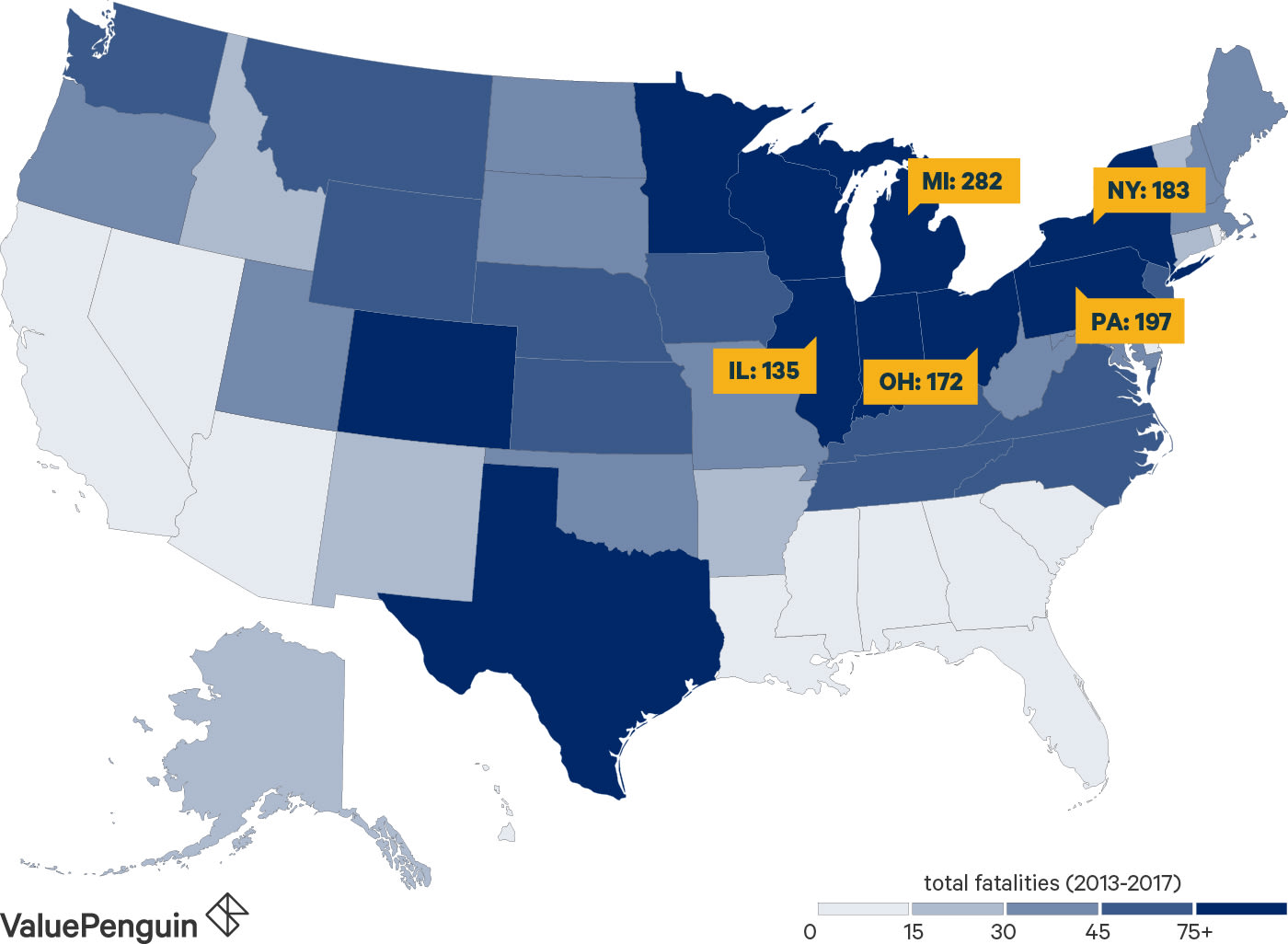Auto Insurance
The Deadliest States For Winter Driving

From 2013 to 2017, there were 2,718 fatalities that resulted from winter weather-related car crashes, as caused by snow, sleet or ice on U.S. roadways. However, as winters are harsher in some regions, there is a handful of states that account for a vast majority of these winter driving deaths.
Deadliest states for winter driving
In terms of fatalities, the most dangerous states for winter driving are Michigan, Pennsylvania, New York, Ohio, and Illinois. These 5 states combined account for 36% of all winter driving fatalities.

Worst Cities in Michigan for Winter Driving
City | Fatalities |
|---|---|
| Detroit | 11 |
| Oshtemo | 4 |
| Lansing | 3 |
| Pontiac | 3 |
| Romulus | 3 |
Worst Roads in Michigan for Winter Driving
Road | Fatalities |
|---|---|
| I-94 | 15 |
| I-75 | 12 |
| I-96 | 11 |
| US-31 | 7 |
| US-41 | 7 |
Worst Cities in Pennsylvania for Winter Driving
City | Fatalities |
|---|---|
| Pittsburgh | 6 |
| Philadelphia | 4 |
| Lewistown | 2 |
| McClure | 2 |
| Scranton | 2 |
Worst Roads in Pennsylvania for Winter Driving
Road | Fatalities |
|---|---|
| I-80 | 12 |
| I-78 | 6 |
| US-11 | 6 |
| US-6 | 6 |
| I-79 | 4 |
Worst Cities in New York for Winter Driving
City | Fatalities |
|---|---|
| New York City - Queens | 7 |
| Circleville | 5 |
| Rochester | 5 |
| Brookhaven | 4 |
| Fallsburg | 4 |
Worst Roads in New York for Winter Driving
Road | Fatalities |
|---|---|
| SR-104 | 9 |
| SR-5 | 7 |
| I-90 | 6 |
| US-20 | 5 |
| Lake Avenue (Rochester, NY) | 4 |
Worst Cities in Ohio for Winter Driving
City | Fatalities |
|---|---|
| Columbus | 7 |
| Akron | 4 |
| Youngstown | 4 |
| Austintown | 2 |
| Cambridge | 2 |
Worst Roads in Ohio for Winter Driving
Road | Fatalities |
|---|---|
| I-71 | 7 |
| I-70 | 6 |
| I-80 | 6 |
| CR-67 | 3 |
| I-76 | 3 |
Worst Cities in Illinois for Winter Driving
City | Fatalities |
|---|---|
| Chicago | 18 |
| Homer Glen | 2 |
| Hometown | 2 |
| Round Lake Beach | 2 |
| Sugar Grove | 2 |
Worst Roads in Illinois for Winter Driving
Road | Fatalities |
|---|---|
| I-55 | 5 |
| I-57 | 4 |
| I-39 | 3 |
| I-74 | 3 |
| Lake Street (Chicago) | 3 |
Full list of winter-driving fatalities by state
Rank of total fatalities (2013-2017) | State/District | Average # of annual fatalities per 100 below-freezing days | Rank of annual fatalities per 100 below-freezing days | Total # of fatalities (2013-2017) |
|---|---|---|---|---|
| 1 | Michigan | 37.0 | 2 | 282 |
| 2 | Pennsylvania | 34.2 | 3 | 197 |
| 3 | New York | 27.9 | 5 | 183 |
| 4 | Ohio | 28.3 | 4 | 172 |
| 5 | Illinois | 21.1 | 6 | 135 |
| 6 | Wisconsin | 17.7 | 8 | 132 |
| 7 (tie) | Indiana | 20.9 | 7 | 123 |
| 7 (tie) | Minnesota | 14.1 | 10 | 123 |
| 9 | Colorado | 11.3 | 14 | 95 |
| 10 | Texas | 48.8 | 1 | 88 |
| 11 | Iowa | 8.7 | 20 | 64 |
| 12 | Kentucky | 12.8 | 12 | 55 |
Winter driving tips
Driving in winter weather is certainly dangerous, and for many Americans, it is an unavoidable part of daily life for a good portion of the year. Because of this, it is important to make sure you, your vehicle and even your auto insurance coverage are prepared for the snowy and icy roads.
Drive carefully: When the weather gets nasty, one of the best ways to keep yourself safe is to adjust your driving habits. Avoid behaviors that increase the risk of getting into an accident, such as speeding, texting while driving and impaired driving. Not only is this good advice from a safety standpoint, but from a financial standpoint as well. Auto insurance rates could increase by as much as 33% after an at-fault accident. Note that the Federal Motor Carrier Safety Administration recommends reducing your normal driving speed by one-half in snowy conditions.
Prepare your vehicle: Making sure your vehicle is prepared could be the difference between life and death this winter. Investing in a good set of snow tires could be well worth the investment if it means avoiding getting into an accident. Additionally, some insurers may offer you a discount for safety equipment, such as winter tires, which can help offset the cost. Additional tips include making sure your vehicle is properly maintained before the winter starts (check the battery, lights and fluids) and storing water and flares in your car in case you are stranded.
Make sure your insurance is ready for the winter: If you have only basic liability coverage, you could be on the hook for damage to your car caused by adverse weather, such as hail or falling tree branches. To be covered under these circumstances, you'll need to have comprehensive coverage. Also consider adding emergency roadside assistance coverage, which covers the cost of extrication if you slide your car into a ditch.
Methodology
We analyzed the total number of fatalities caused by winter-driving crashes from 2013 to 2017, as reported by the National Highway Traffic Safety Administration's Fatality Analysis Reporting System. We considered crashes that occurred under the following atmospheric conditions to be winter weather-related crashes:
- Sleet or hail
- Snow
- Blowing snow
- Freezing rain or drizzle
Data on the average annual number of days where the temperature dropped below freezing was gathered from Comparative Climatic Data tables, maintained by the National Oceanic and Atmospheric Administration. Specifically, we averaged the mean number of days with a minimum temperature of 32ºF or less across the major U.S. weather observing stations in each state.
